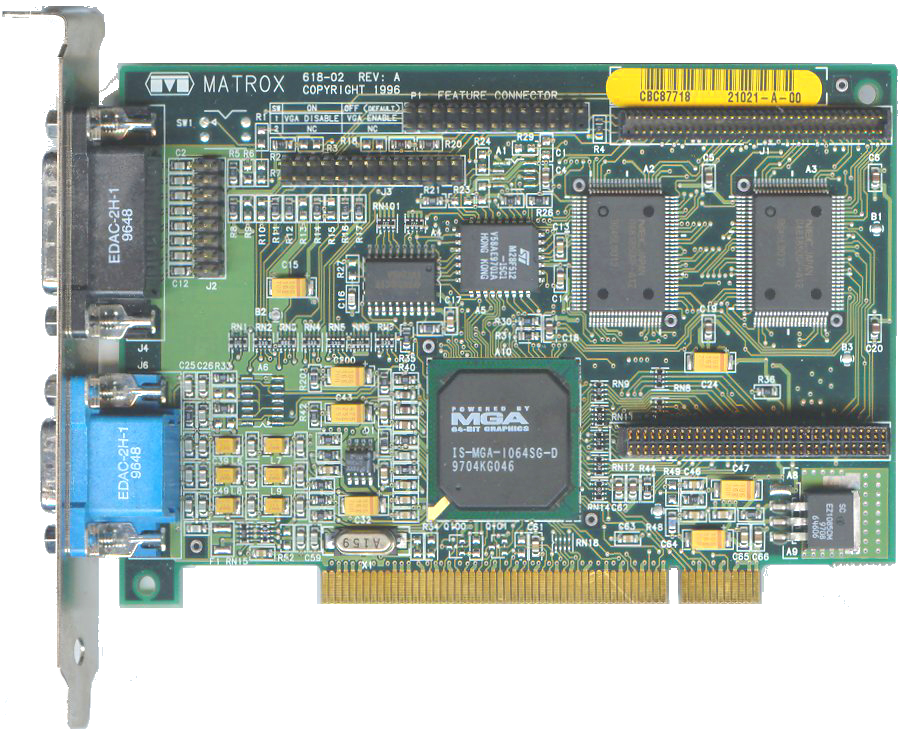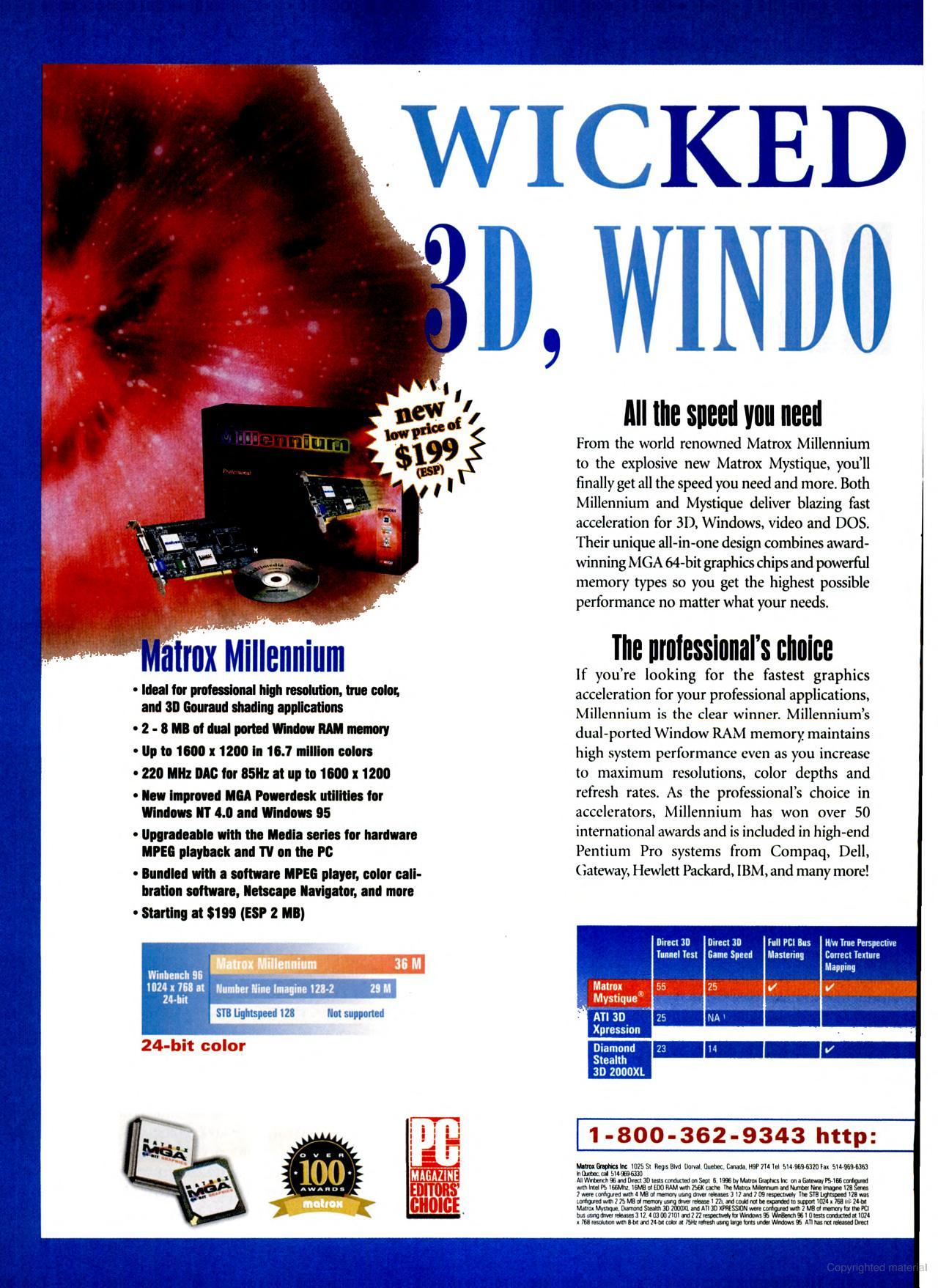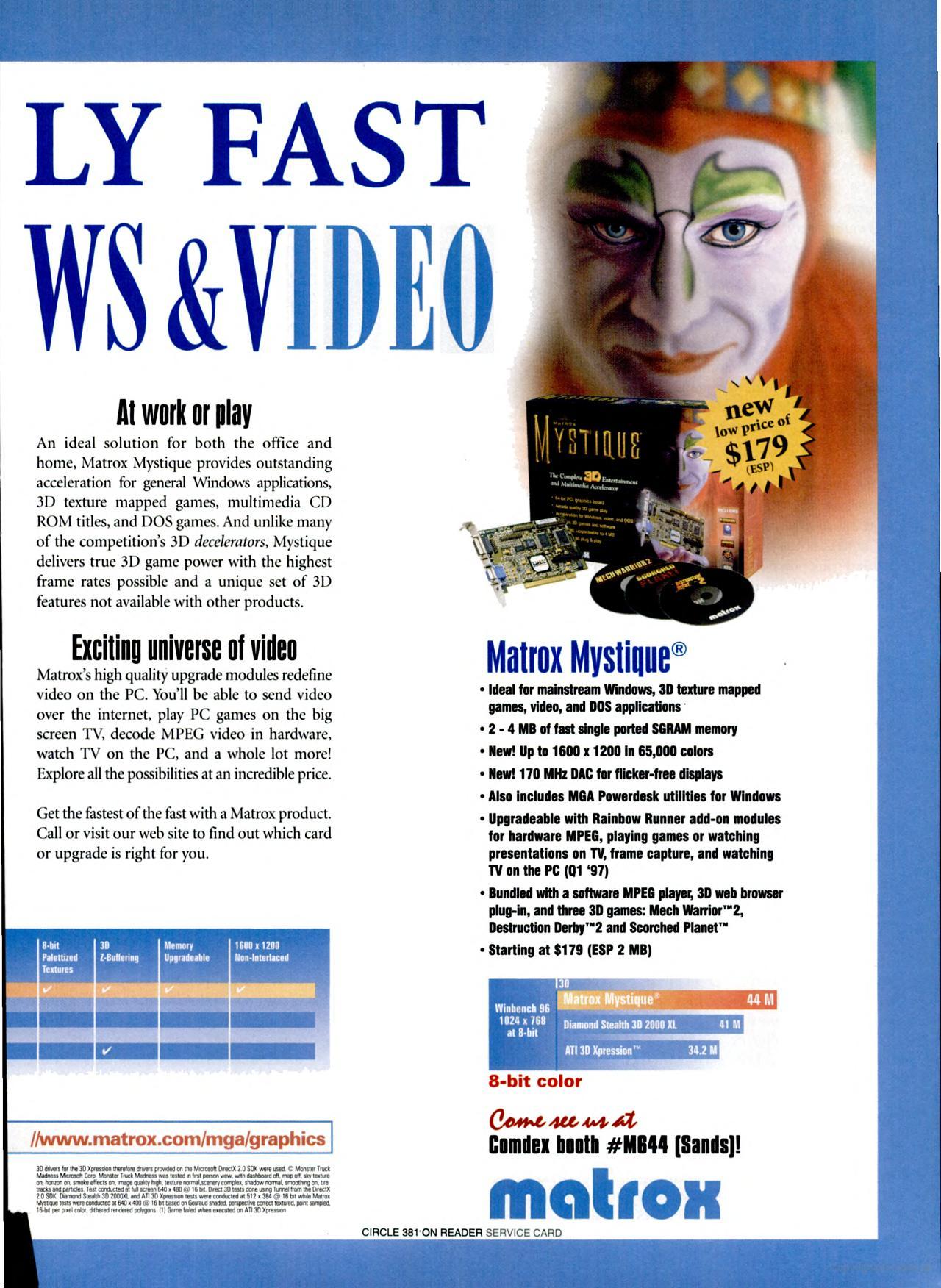Matrox Mystique
The Mystique was introduced in 1996 as a way for Matrox to better compete in the new 3D hardware accelerator market.
 |
Released | May 1996 |
| Bus | PCI | |
| Chipset | IS-MGA-1064SG-D, IS-MGA-1064SG-H | |
| Standards | Hercules, CGA, EGA, VGA | |
| Memory | 2 MB, 4 MB or 8 MB SGRAM (64-bit) | |
| Ports | 15-pin DSUB (video out) 26-pin VGA Feature connector Memory expansion headers |
|
| RAMDAC | 135 MHz up to 170 MHz (8-bit colour depth) | |
| Part # | - | |
| FCC ID | - | |
| Price | At launch: $499 (4 MB), $149 (2 MB SGRAM upgrade module), Dec 1996: $259 (4MB), Apr 1997: $279 (2MB) | |
| See Also | Mystique 220, Millennium |
The Mystique was Matrox' response to gamers demands for a 'proper' 3D card with a texturing engine, since the first Millennium had none. It was their first card that was directly targeted at the consumer market.
In a single chip (the MGA-1064SG) Matrox integrated the RAMDAC and video engine with a hardware scaler. The new texturing engine handled perspective correction, transparency lookup table, lighting in true colour precision, and dithering, though despite being the best 3D card from Matrox even through 1997, it did not have bilinear filtering, fogging, mip-mapping or anti-aliasing - instead relying on "nearest neighbour" interpolation. It also didn't directly support OpenGL.
Its core clock ran at 50 - 60 MHz.
As was typical for Matrox, their 2D image quality was fantastic - noticeably better than its peers at the time such as S3 ViRGE and ATI Mach64-based cards. 3D performance of this new chip, however, was sub-par. Mystique was a much cheaper card than the Millennium with a slower RAMDAC (even though it was integrated into the single graphics processor chip) and slower memory, though its 2D performance was almost as fast as Millennium up to XGA resolutions (1024 x 768).
It supports the following VGA and up graphics modes:
| Resolution | Max. Refresh Rate (Hz) | Max. Colour Depth |
|---|---|---|
| 1600 x 1200 | 60* | 8-bit |
| 1280 x 1024 | 85 | 8-bit |
| 1152 x 864 | 75 | 16-bit |
| 1024 x 768 | 85 | 16-bit |
| 800 x 600 | 85 | 32-bit |
| 640 x 480 | 85 | 32-bit |
*Mystique 220 is able to display 1600 x 1200 at 75 Hz refresh rate.
The first Mystiques came with a 50 MHz core and memory running at 75 MHz. Without changing the model or version, a variety of flavours seemed to follow, such as 55/82.5 MHz and 60/90 MHz. It appears Matrox spent 1996 to mid-1997 gradually raising the Mystique's clock speeds.
According to the company at the time, the MGA‑1064SG could process 25 million texels/second where the texels were perspective correct, Gouraud shaded, transparent, Colour Lookup Table 8 expanded to 16‑bit RGB, and Z‑buffered. Game and 3D API support included DirectDraw and Direct3D as well as Criterion’s Renderware.
Mystiques fitted with 4 MB from factory were upgradable to 8 MB. The 8 MB cards from factory simply had the 4 MB memory expansion module fitted. Another option header on the board allowed you to connect the Rainbow Runner - an MPEG-1 and AVI video playback module that included further video input and output ports. A Rainbow Runner TV module added a TV tuner.
The retail version of Mystique came bundled with three 3D games: MechWarrior 2, Destruction Derby 2 and Scorched Planet. IBM shipped their desktop and mini-tower PC 300PL range with Mystique cards in 1997.
Tip: If you get frequent lock-ups or freezes disable the "Use Bus Mastering" feature under the device driver Settings tab. This Bus Mastering is present on all Mystique models and will increase your frame rates but unfortunately increases instability
Summing up: Mystique had arguably the best 2D quality and performance for a 1996 and even 1997 card. For 3D gaming, performance still beat the early S3 ViRGE and ATI Mach 64 cards though 3D image quality was poorer due to its limited 3D feature set. If you have a 3dfx Voodoo 1 card, use that in conjunction with this for better 3D performance.
Board Revisions
I have no board revision information for the Mystique.
Competition
In the Media
Matrox says it sacrificed some effects for a higher frame rate, which might be an acceptable tradeoff for fast-paced game action. Indeed, on our 3-D tests, the Mystique spits out Direct3D frames faster than most of its competitors. The subjective game-playing experience - taking into account frame rate - place the Mystique second only to Intergraph's Reactor in this roundup.
In the 2-D arena, the Mystique was a consistent performer, placing in the top ten of tested boards on our WinMark and Winstone tests. And its video playback quality (for both .AVI and MPEG) is much improved over the Millennium's, incorporating both x and y interpolation. These are stable, intelligently designed products that stack up well against their current competition. The mature Millennium can deliver the big-screen 2-D performance business and graphics users need. The Mystique couples respectable 2-D acceleration for business applications with good - if not religiously rendered - 3-D visuals for game players."
PC Magazine, 3 Dec 1996
Matrox has given us a valiant effort, but because of the Mystique's fatal flaw, the card has already earned the nickname of the "Mistake".
The Mystique is a solid performer with a few key pieces missing. The lack of filtering can be seen as nothing less than a fatal flaw."
NEXT Generation, February 1997


An advert for the Millennium and Mystique, Dec 1996
Setting it Up
I have no information on configuring the Mystique.
Downloads
Operation Manual Get in touch if you can provide this missing item! |
Original Utility Disk Get in touch if you can provide this missing item! |
Video BIOS ROM Get in touch if you can provide this missing item!
|
More Pictures